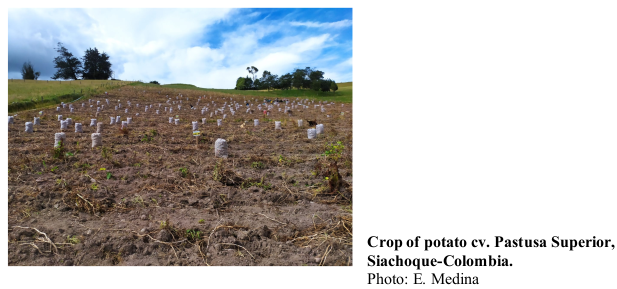Physiological performance of potatoes (Solanum tuberosum L.) under two irrigation systems and tillage in a high Andean zone of Colombia

Abstract
Potato cultivation in the Andean Colombian region is vulnerable to variability and climate change, due to the more use of water and increase in temperature, affecting the sustainability of the cultivation system due to increased demand for irrigation. With the purpose of evaluating two types of tillage (conventional and conservation) and irrigation systems (sprinkler and drip) and the physiological performance of potato cv. Pastusa Superior, a crossed block design with four treatment and a non-irrigated control was used. Dry matter accumulation, marketable yield and physiological variables were evaluated: transpiration, net photosynthesis or CO2 assimilation rate, intercellular CO2 concentration, stomatal conductance, intrinsic water use efficiency, efficient use of transpiration (every 21 days after emergence of 50% of the pants), soil variables bulk density, total porosity and weighted average aggregate diameter before and after cultivation, and water productivity. Drip irrigation increased yield by 25.53% compared to no irrigation. No effect of tillage on yield, soil variables and physiological performance was found, however, conservation tillage improved the physical properties evaluated. Drip irrigation favored the performance of physiological variables and water productivity, making it an important option to improve crop productivity in dry areas in order to improve yield and water productivity.
Keywords
Drought, Water management, Leaf gas exchange, Climate change, Cultural practices
References
- Agronet. 2024. Área, producción y rendimiento nacional por cultivo: papa. In: https://www.agronet.gov.co/estadistica/Paginas/home.aspx?cod=1; consulted: March, 2024.
- Andrade, J., A. Cerrudo, R. Rizzalli, and J. Monzón. 2012. Sunflower–soybean intercrop productivity under different water conditions and sowing managements. Agron. J. 104(4), 1049-1055. Doi: 10.2134/agronj2012.0051
- Djaman, K., S. Irmak, K. Koudahe, and S. Allen. 2021. Irrigation management in potato (Solanum tuberosum L.) production: a review. Sustainability 13, 1504. Doi: https://doi.org/10.3390/su13031504
- Djaman, K., K. Koudahe, H.D. Koubodana, A. Saibou, and S. Essah. 2022. Tillage practices in potato (Solanum tuberosum L.) production: a review. Am. J. Potato Res. 99, 1-12. Doi: https://doi.org/10.1007/s12230-021-09860-1
- Escalona, J.M., J. Flexas, J. Bota, and H. Medrano. 2003. Distribution of leaf photosynthesis and transpiration within grapevine canopies under different drought conditions. Vitis 42, 57-64.
- FAO. 2022. Duplicar la producción mundial de papa en 10 años es posible. In: https://www.fao.org/newsroom/detail/doubling-global-potato-production-in-10-years-is-possible/es; consulted: March, 2024.
- García, D., J. Cárdenas, and A. Parra. 2018. Evaluación de sistemas de labranza sobre propiedades físico-químicas y microbiológicas en un Inceptisol. Rev. Cienc. Agríc. 34(1) 16-25. Doi: http://doi.org/10.22267/rcia.183501.79
- Gervais, T., A. Creelman, X.-Q. Li, B. Bizimungu, D. De Koeyer, and K. Dahal. 2021. Potato response to drought stress: physiological and growth basis. Front. Plant Sci. 12, 698060. Doi: http://doi.org/10.3389/fpls.2021.698060
- Guerrero, J., M. Cabezas, and J. Galvis. 2020. Efecto de dos sistemas de riego sobre la producción y uso eficiente del agua en el cultivo de papa variedad Diacol Capiro. Rev. Invest. Agrar. Ambient. 11(1), 41-51. Doi: https://doi.org/10.22490/21456453.3080
- Hall, A. and V. Sadras. 2009. Whither crop physiology. pp. 545-570. In: Sadras, V. and D. Calderini (eds). Crop physiology. Applications for genetic Improvement and agronomy. Academic Press, San Diego, CA.
- Hill, D., D. Nelson, J. Hammond, and L. Bell. 2021. Morphophysiology of potato (Solanum tuberosum) in response to drought stress: paving the way forward. Front. Plant Sci. 11, 597554. Doi: https://doi.org/10.3389/fpls.2020.597554
- Hou, X. and R. Li. 2019. Interactive effects of autumn tillage with mulching on soil temperature, productivity and water use efficiency of rainfed potato in loess plateau of China. Agricul. Water Manage. 224, 105747. Doi: https://doi.org/10.1016/j.agwat.2019.105747
- Kafkafi, U. and J. Tarchitzky. 2012. Fertirrigación, una herramienta para una eficiente fertilización y manejo del agua. Asociación Internacional de la Industria de Fertilizantes (IFA); Instituto Internacional de la Potasa (IIP), Quito.
- King, B.A., J.C. Stark, and H. Neibling. 2020. Potato irrigation management. pp. 417-446. In: Stark, J., M. Thornton, and P. Nolte (eds.). Potato production systems. Springer, Cham, Switzerland. Doi: https://doi.org/10.1007/978-3-030-39157-7_13
- Lozano-Povis, A., C.E. Alvarez-Montalvan, and N. Moggiano. 2021. El cambio climático en los andes y su impacto en la agricultura: una revisión sistemática. Sci. Agropecu. 12(1), 101-108. Doi: http://doi.org/10.17268/sci.agropecu.2021.012
- MADR, Ministerio de Agricultura y Desarrollo Rural. 2019. Estrategia de ordenamiento de la producción - cadena productiva de la papa y su industria. Bogotá.
- Núñez, J., J.C. Carvajal, O. Mendoza, and D. Carrero. 2018. Indicadores del impacto del cambio climático en la agricultura familiar andina colombiana. Rev. Iberoam. Bioecon. Cambio Climát. 4(7). Doi: https://doi.org/10.5377/ribcc.v4i7.6309
- Ñústez, C., M. Santos, and M. Segura. 2009. Acumulación y distribución de materia seca de cuatro variedades de papa (Solanumtuberosum L.) en Zipaquirá, Cundinamarca (Colombia). Rev. Fac. Nal. Agrono. Medellín 62(1), 4823-4834.
- Pagliai, M., N. Vignozzi, and Pellegrini. 2004. Soil structure and the effect of management practices. Soil Tillage Res. 79, 131-143.
- Sarangi, S.K., B. Maji, P.C. Sharma, S. Digar, K.K. Mahanta, D. Burman, U.K. Mandal, S. Mandal, and M. Mainuddin. 2021. Potato (Solanum tuberosum L.) cultivation by zero tillage and paddy straw mulching in the saline soils of the Ganges Delta. Potato Res. 64, 277-305. Doi: https://doi.org/10.1007/s11540-020-09478-6
- USDA, United States Department of Agriculture. 2010. Keys to soil taxonomy. 11th ed. Washington, DC.
- Vélez-Sánchez, J., F. Casierra-Posada, and G. Fischer. 2023. Effect of Regulated Deficit Irrigation (RDI) on the growth and development of pear fruit (Pyrus communis L.), var. Triunfo de Viena. Sustainability 15, 13392. Doi: https://doi.org/10.3390/su151813392
- Zhang, S., H. Wang, X. Sun, J. Fan, F. Zhang, J. Zheng, Y. Li. 2021. Effects of farming practices on yield and crop water productivity of wheat, maize and potato in China: A meta-analysis. Agric. Water Manag. 243, 106444. Doi: https://doi.org/10.1016/j.agwat.2020.106444
- Zhang, P., X. Yang, K. Manevski, S. Li, Z. Wei, M.N. Andersen, and F. Liu. 2022. Physiological and growth responses of potato (Solanum Tuberosum L.) to air temperature and relative humidity under soil water deficits. Plants 11(9), 1126. Doi: https://doi.org/10.3390/plants11091126
